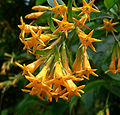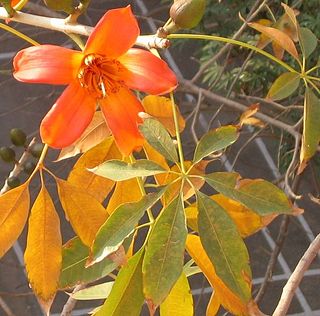
Bombacaceae were long recognised as a family of flowering plants or Angiospermae. The family name was based on the type genus Bombax. As is true for many botanical names, circumscription and status of the taxon has varied with taxonomic point of view, and currently the preference is to transfer most of the erstwhile family Bombacaceae to the subfamily Bombacoideae within the family Malvaceae in the order Malvales. The rest of the family were transferred to other taxa, notably the new family Durionaceae. Irrespective of current taxonomic status, many of the species originally included in the Bombacaceae are of considerable ecological, historical, horticultural, and economic importance, such as balsa, kapok, baobab and durian.
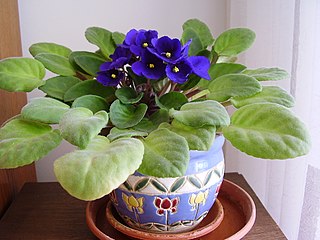
Gesneriaceae, the gesneriad family, is a family of flowering plants consisting of about 152 genera and ca. 3,540 species in the tropics and subtropics of the Old World and the New World, with a very small number extending to temperate areas. Many species have colorful and showy flowers and are cultivated as ornamental plants.

Salpiglossis sinuata, the painted tongue, scalloped tube tongue, velvet trumpet flower, palito amargo or panza de burro ( Spanish : donkey's paunch ), is a flowering plant belonging to the subfamily Cestroideae of the nightshade family Solanaceae, native to southern Chile.
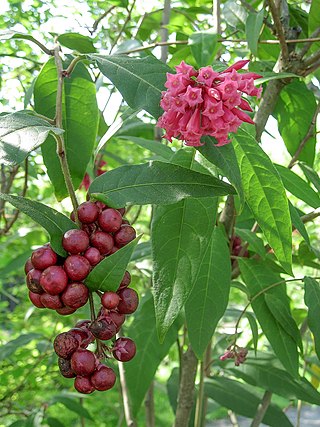
Cestrum is a genus of — depending on authority — 150-250 species of flowering plants in the family Solanaceae. They are native to warm temperate to tropical regions of the Americas, from the southernmost United States south to the Bío-Bío Region in central Chile. They are colloquially known as cestrums or jessamines.
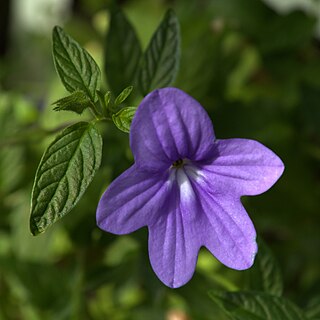
Browallia is a small genus of seven species of flowering plants belonging to the nightshade family Solanaceae. It is named after Johannes Browallius (1707–1755), also known as Johan Browall, a Swedish botanist, physician and bishop. The genus is closely related to the monotypic genus Streptosolen, the single species of which was published initially under the name Browallia jamesonii.
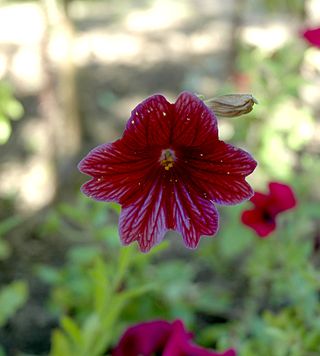
Salpiglossis is a genus of flowering plants belonging to the subfamily Cestroideae of family Solanaceae. It is closely related to the genus Reyesia, with which it makes up the tribe Salpiglossideae. Species in the genus Salpiglossis are found in Mexico, Argentina and Chile.
Sessea is a genus of 19 accepted species of shrubs, small trees and climbers belonging to the subfamily Cestroideae of the plant family Solanaceae. The flowers of Sessea are so similar to those of Cestrum that the genera cannot usually be told apart, unless the plants are in fruit. Then their distinguishing characteristics become immediately apparent; plants of the genus Sessea bearing dehiscent capsules dispersing winged seeds, while those belonging to the genus Cestrum bear juicy berries containing prismatic seeds. The flowers of both Sessea and Cestrum have tubular corollas that are long exserted from small calyces.

Iochroma arborescens is a species of flowering plant in the genus Iochroma, belonging to the nightshade family Solanaceae. Formerly it was considered the single species in the monotypic genus Acnistus. Common names include gallinero, mata-gallina, fruta-de-sabiá, hollowheart, wild tobacco, siyou, bastard sirio, galán arbóreo, tabaco de monte, nigüito, marieneira, güitite, and tabak djab.

Cestrum elegans, the purple cestrum, red cestrum, or bastard jasmine, is a species of flowering plants in the genus Cestrum.
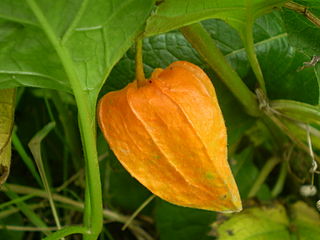
Physaleae is a tribe of flowering plants in the subfamily Solanoideae of the family Solanaceae.

Vestia is a monotypic genus of flowering plants in the family Solanaceae containing the single species Vestia foetida. Its principal common names in the Mapudungun language of its native Chile are Huevil and Chuplín. Other Chilean names include Chuplí, Echuelcún and Palqui (negro), while an English common name Chilean box thorn has also been coined recently in reference to a certain similarity of the plant to some species in the box thorn / wolfberry genus Lycium. Vestia foetida is endemic to central and southern Chile, being found in an area stretching from the Valparaíso Region in the north to Chiloé Island in the south. Growing to 2 m (7 ft) tall by 1.5 m (5 ft) broad, it is an evergreen shrub with glossy, privet-like, mid-green leaves. In spring and summer it bears tubular yellow flowers to 3 cm (1 in) long, with stamens so markedly exserted as to recall those of certain Fuchsia species, followed by 4-valved, ovoid capsules to 1 cm (0 in), containing small, prismatic seeds.

Jaltomata is a genus of plants in the family Solanaceae. According to molecular phylogenies, Jaltomata is the sister genus to Solanum, which includes tomato, potato, and eggplant. Jaltomata has a neotropical distribution, in that species occur from the United States southwest through Latin America, and into the Andean region of South America. Species encompass a wide range of vegetative and reproductive trait variation, including growth habit, floral size, shape and color, as well as fruit size and color. The fruits of some of the species are eaten by humans in Latin and South America. Depending on the species, fruits may be red, green, orange, or dark purple.

The Solanaceae, or nightshades, are a family of flowering plants that ranges from annual and perennial herbs to vines, lianas, epiphytes, shrubs, and trees, and includes a number of agricultural crops, medicinal plants, spices, weeds, and ornamentals. Many members of the family contain potent alkaloids, and some are highly toxic, but many—including tomatoes, potatoes, eggplant, bell and chili peppers—are used as food. The family belongs to the order Solanales, in the asterid group and class Magnoliopsida (dicotyledons). The Solanaceae consists of about 98 genera and some 2,700 species, with a great diversity of habitats, morphology and ecology.
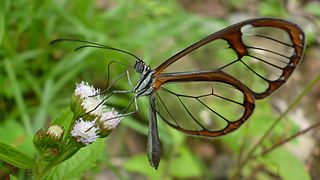
Pseudoscada erruca is a South-American species of brush-footed butterfly in the Godyridina subtribe of Ithomiini. It was described in 1855 by William Chapman Hewitson as Ithomia erruca.

Reyesia is a small genus of four species of flowering plants belonging to the subfamily Cestroideae of the nightshade family Solanaceae. It is closely related to the genus Salpiglossis, which provides the ornamental species Salpiglossis sinuata. Together, the genera Reyesia and Salpiglossis form the tribe Salpiglossideae within the Cestroideae. Historically, the species now placed in Reyesia have been held by some authors to belong to Salpiglossis, but are currently placed in a genus of their own by virtue of their tiny flowers and peculiar androecium.

Petunioideae is a subfamily of the flowering plant family Solanaceae, the nightshades. It contains thirteen genera, as follows:

Juanulloa, the goldfingers, are a genus of flowering plants in the family Solanaceae, native to Central and South America.
Trozelia is a genus of flowering plants belonging to the family Solanaceae. It is also within the Physalinae (Miers) Hunz. subtribe.
Saracha is a genus of flowering plants belonging to the family Solanaceae. It is in the Solanoideae subfamily.



